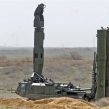
Armenia Displays Sophisticated Air Defense Systems
Publication: Eurasia Daily Monitor Volume: 8 Issue: 13
By:

After several years of silence on the issue, Armenia has officially confirmed the existence of the sophisticated Russian-supplied S-300 air defense system in its military arsenal and demonstrated this by broadcasting video evidence. The authorities in Yerevan have also approved a five-year plan to modernize the Armenian armed forces, which envisages the acquisition of precision-guided surface-to-surface missiles.
These developments reflect Armenia’s intensifying arms race with Azerbaijan in the unresolved conflict over Karabakh. They were clearly made possible by a further deepening of Russian-Armenian military ties that led to the signing of a new defense agreement between Moscow and Yerevan in August 2010. The accord signed during Russian President Dmitry Medvedev’s state visit to Armenia extended Russia’s lease on a military base in the country by 24 years, until 2044, and upgraded its security mission. It also commits Moscow to supplying the Armenian army with “modern and compatible weaponry and (special) military hardware” (Armenian Public Television, December 25).
Moscow had significantly reinforced the combat capacity of the Russian base, headquartered in the northern Armenian city of Gyumri, by deploying a division of S-300 systems and two dozen MiG-29 fighter jets there in the late 1990’s. The two countries agreed to jointly defend Armenia’s airspace in the same period. Their integrated air defense system was given a “regional” status by the Russian-led Collective Security Treaty Organization (CSTO) in early 2007. Moreover, in 2007, Russian military officials first indicated that the Armenian military had its own S-300’s. The then commander-in-chief of the Russian Air Force, Colonel-General Vladimir Mikhailov, said that Moscow was modernizing Armenian air defense capabilities and would continue doing so in future. Mikhailov’s deputy, Lieutenant-General Aytech Bizhev, revealed that as part of that assistance, Armenian officers had been trained to operate the long-range S-300 surface-to-air missile system known for its precision (www.armenialiberty.org, 15 February 2007).
It was not until December 20, 2010 that Yerevan explicitly confirmed possessing S-300’s. In a written statement, the Armenian defense ministry stated that Defense Minister, Seyran Ohanian, visited an anti-aircraft military unit and “familiarized himself with the work of the state-of-the-art S-300 air-defense systems.” The statement added that Ohanian also inaugurated a new Russian-Armenian “air-defense command point” featuring S-300’s.
Five days later, the ministry aired on state television a ten-minute report showcasing the Russian-made systems, test-firing missiles in an undisclosed location in Armenia and providing a detailed description of their technical-tactical characteristics. The footage also featured an excerpt from a speech delivered by Ohanian to military personnel. “We have acquired new means [of air defense] … and those acquisitions will be expanded in 2011. The air defenses of our enemies do not have means of this type and quantity,” Ohanian said (Armenian Public Television, December 25).
Neither Ohanian, nor other military officials specified precisely when the Armenian military received the S-300’s or at what cost. Armenia’s official defense budget in 2010 was an equivalent of about $400 million, a sum comparable to the market price of two or more S-300 divisions. Moscow is thus likely to have delivered the systems to its main regional ally at a knockdown price or even free of charge.
Earlier in December 2010, Armenian President, Serzh Sargsyan, and the National Security Council approved the State Program of Developing Weaponry and Military Hardware in 2011-2015. Sargsyan’s office released few details of the modernization plan, saying only that the Armenian army will procure more “state-of-the-art weapons” (Statement by the Armenian presidential press service, December 11).
The modernization plan is essentially based on two documents approved in August 2010 by an ad hoc government task force. Ohanian told journalists then that Armenia will enhance its “long-range strike capacity” and will be able to “thwart enemy movements deep inside the entire theater of hostilities.” Ohanian did not deny that the planned arms acquisitions are a response to the ongoing military build-up in Azerbaijan and Baku’s growing threats to resolve the Karabakh conflict by force (www.lragir.am, August 10). Azerbaijani defense spending, fuelled by the country’s massive oil revenues, is projected to total over $3 billion and will slightly surpass Armenia’s entire state budget in 2011.
In a subsequent interview with Radio Free Europe’s Armenian service, Ohanian noted that the precision-guided weapons sought by Yerevan would potentially target the “strategic facilities” of Armenia’s hostile neighbors. The Armenian military is believed to already possess short-range tactical missiles capable of striking military and civilian targets in Azerbaijan (RFE/RL, December 13).
The linkage between the military modernization plan and the Russian-Armenian defense pact was effectively acknowledged by Artur Baghdasarian, the Secretary of the National Security Council. Baghdasarian also reaffirmed the two governments’ intention to set up joint defense ventures to be based in Armenia. The Kremlin called into question its supposedly pro-Armenian stance when it pointedly declined to refute, prior to Medvedev’s visit to Yerevan, Russian press reports that it also plans to sell S-300’s to Azerbaijan. Armenian opposition figures and commentators voiced serious concerns about this possibility, saying that it would change the balance of forces in the conflict zone in Azerbaijan’s favor. Armenian officials dismissed such fears, with Ohanian claiming that his forces “know the ways of reducing the effectiveness of such systems” (Armenian Public Television, December 25).
Whatever the reality, Yerevan sees no option other than to continue relying heavily on military cooperation with Moscow. With internationally mediated Armenian-Azerbaijani peace talks remaining deadlocked and the vast majority of Armenians still strongly opposed to any peaceful settlement that would place Karabakh under Azeri control, Armenia currently seems to lack viable policy alternatives.




